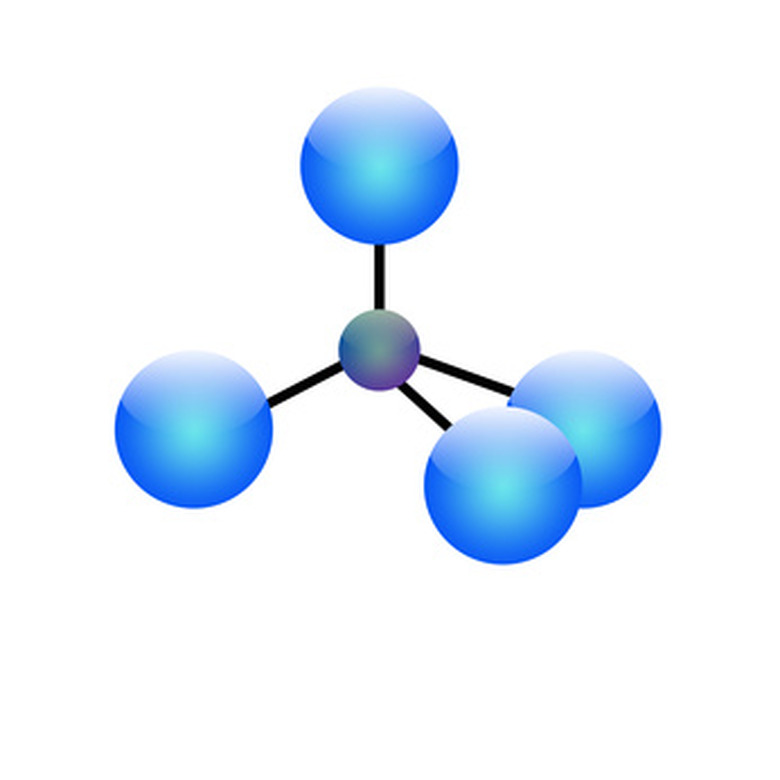What Is The Relationship Between A Molecule & An Atom?
All matter in is a massive collection of molecules. Molecules are a joining of two of more atoms, which are the most basic unit of physical matter. Atoms are given a different weight based on the number of protons and neutrons in the nucleus and electrons in the surrounding cloud. The same electromagnetic force that keeps a single atom together can also hold two or more atoms together to form a molecule, while numerous molecules join together to form matter.
Atoms
Atoms
Atoms, the basic buildings blocks of life, consist of three particles: neutrons, protons and electrons. The vast majority of the atom's mass is found in the nucleus, in the center of the atom, consisting of protons and neutrons, while electrons cloud the area outside of the nucleus. Protons are positively charged while electrons are negatively charged and neutrons are neutral. An atom's atomic weight is determined by the number of protons and neutrons, while its atomic number is equal to only the amount of protons present. While electrons may differ, in the case of ions, which have electrons lost or gained, and neutrons may not be present, as in hydrogen atoms which have no neutrons, the number of protons in an atom never changes. Since electrons may be gained or lost and neutrons may not be included, elements are identified by atomic number, because the number of protons never changes. The periodic table of elements is a chart displaying all known elements to exist, partially arranged by number. The first and simplest element, hydrogen, with only one proton and one electron, is atomic number one, while larger elements, such as radium at number 88, are displayed in the order of their number of protons.
Molecules
Molecules
Molecules are the combination of one or more atoms into a specific substance. Perhaps the best-known combinations are water (H2O), carbon dioxide (CO2) and oxygen (O2, more accurately dioxygen). The chemical formula of a molecule (such as H2O) shows the specific atoms in the substance as well as how many of each element is found. In the case of water (H2O) there are two hydrogen atoms and one oxygen atom in every molecule of water. If the molecule were to lose one of these atoms, the compound would cease to be water.
Bonds
Bonds
Molecules are held together because the positive and negative parts of the atom (protons and electrons, respectively) are attracted to each other. These are called chemical bonds. Each molecule has a positive and negative end, like the sides of a battery, which join with other molecules to create the particular substance. In the case of water, the positively charged oxygen atoms are attracted to the negatively charged hydrogen atom, forming a hydrogen bond.
Compounds
Compounds
Compounds are any combination of more than one element, such as hydrogen and oxygen (water) or sodium and chlorine (salt). While there are only 118 known elements, the specific combination and sequence of atoms creates an infinite amount of possibilities. For example, the chemical compound ethanol, commonly referred to as alcohol, has a chemical formula of C2H5OH. While there are six hydrogen atoms present, the final hydrogen is bonded to the oxygen atom. It's actually the bond of a carbon atom to the hydroxyl (OH) group that distinguishes any organic compound as alcohol but not specifically as ethanol.
Single Elements
Single Elements
Although some substances may consist of only one element, the amount of that element also distinguishes different substances. The oxygen that humans and other animals require is the combination of two oxygen atoms (O2); however, three oxygen atoms (O3) create the substance ozone, which is an essential part of the Earth's atmosphere but can be toxic to organic life.
Cite This Article
MLA
Kroll, Jess. "What Is The Relationship Between A Molecule & An Atom?" sciencing.com, https://www.sciencing.com/relationship-between-molecule-atom-7895221/. 24 April 2017.
APA
Kroll, Jess. (2017, April 24). What Is The Relationship Between A Molecule & An Atom?. sciencing.com. Retrieved from https://www.sciencing.com/relationship-between-molecule-atom-7895221/
Chicago
Kroll, Jess. What Is The Relationship Between A Molecule & An Atom? last modified March 24, 2022. https://www.sciencing.com/relationship-between-molecule-atom-7895221/
